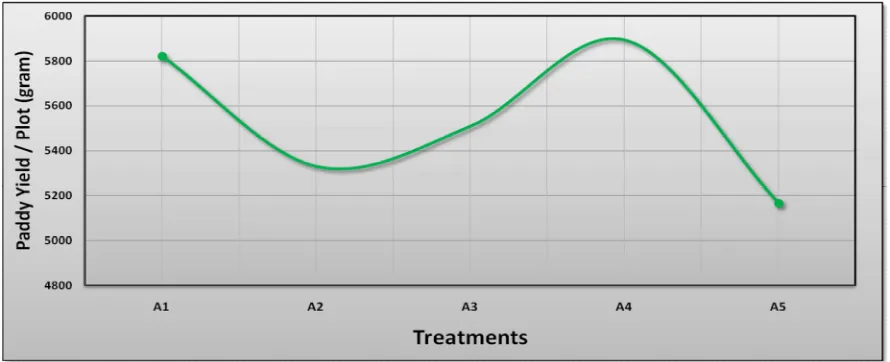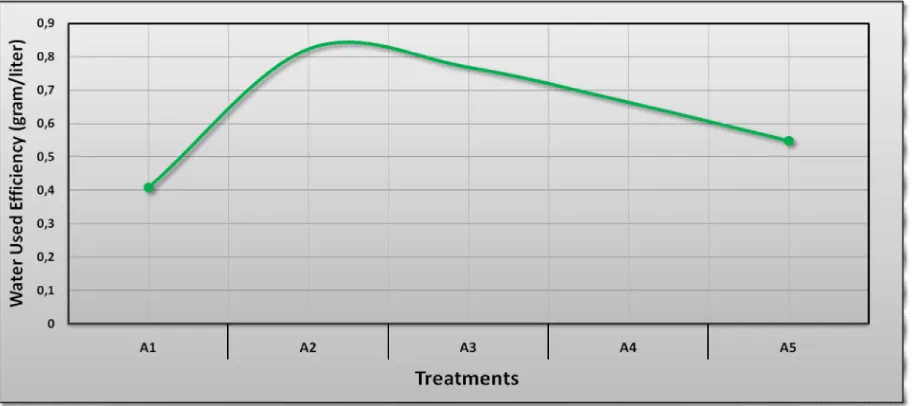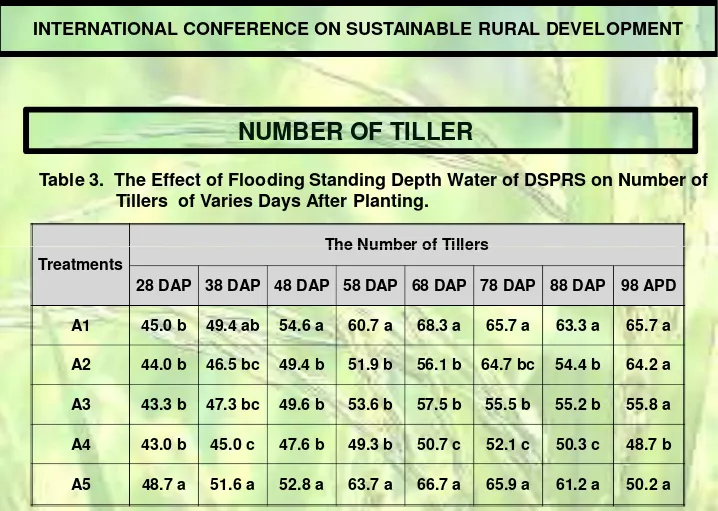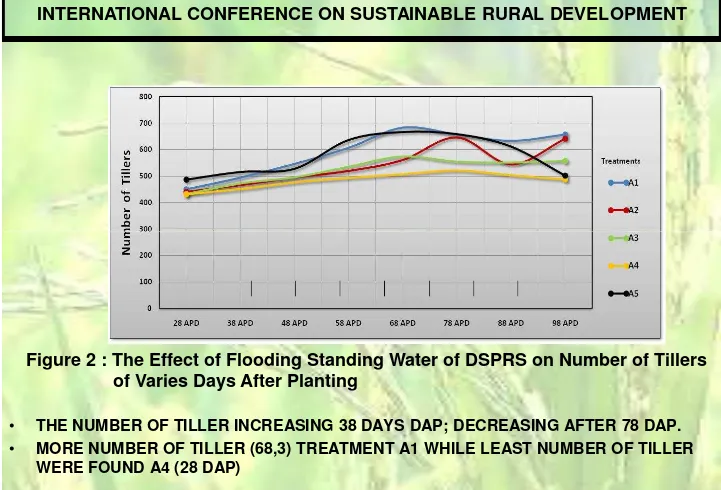INTERNATIONAL CONFERENCE ON
SUSTAINABLE RURAL DEVELOPMENT
DIRECT SEEDING PLANTATION RICE SYSTEM
IS ONE OF ALTERNATIVE
IN AGRICULTURE WATER CONSERVATION
MANAGEMENT ENGINEERING AT FARM
LEVEL
By
NURPILIHAN BAFDAL **
*Paper Presented on International Conference on Sustainable Rural
Development; Purwokerto, 2013
Abstract.
In general the water requirement of low land rice such as paddy needs more water 1 liter/second/ha on his growth, but the planning for the improvement of the development of irrigation should be different to the historical kind of agricultural uses, environment such as soil physics, the size of land climate conditions especially rainfall, growing stage period and paddy varieties. In Asia countries the traditional form of agricultural water used still exist. Traditional way of irrigation water management on farm level for low land rice is countinos flooding water with 8-15 cm depth during whole paddies growth. This type could make finite amount of water area and needs high amount of water.
On farm level should introduce a technology which is low amount of water for low land rice. Nurpilihan (2000) was carried out experiment and obtain that the direct seeding plantation rice system (DPRS), with various water flooding treatment should contribute to improve irrigation from paddies stage. The objective of the study were to determine the effect of varying flooding depths of the stages (vegetative and reproductive) with direct seeding plantation rice system on respon se of paddy yield, number of tillers, paddy height and water use efficiency .
Results of the study showed that:
1. The number of tillers under all treatment were found decreasing after 78 days after transplanting. More number of tiller (68,3) were observed in treatment A1 while least number of tillers were found at treatment A4 with 28 days after transplanting. 2. All treatment resulted in different amount of growth paddy yield but no significantly
effect between flooding irrigated water on paddy yield
3. The treatment A3 gave the highest per liter of water used (0,770 gram). Water used efficiency shallow flooded treatment was higher while treatment A5 gave the lowest return per liter of water used (0,550 gram)
4. Muddy condition during whole paddy growth could give available water and show significant effect for all treatment, so muddy condition good technology to introduced for the farmers.
I. INTRODUCTION
Paddy (Oryza sativa) is dominantly on Asia crop, which is requires an effective water management practice during its growth periode. In the Asia region, Indonesia is one of the major paddy producing country ,although the average yield reported is only 5 ton/ha. One of reasoning the low yield is due to the inadequate supply of water; hence in order to maximize the production and irrigation water application system as a whole, researcher should be found of new plantation rice system such as effective water management.
Irrigation is the artificial supply of water to the soil for the purpose of increased crop production. In many parts of the world the amount and timing of rainfall are inadequate and inappropriate to meet the moisture requirement of crops, and irrigation becomes essential to raise crops near to their maximum yield in such areas. The demand for water in various sectors is increasing day by day, due the climate change water is no longer considered to be an unlimited resources, so its efficient utilization in agriculture demands very careful study.
In general the water requirement of low land rice such as paddy needs 1 litre/second/ha, but the planning for the improvement of the development of irrigation should be different to the historical kind of agricultural uses, environment such as soil physics, the size of land, climate conditions especially rainfall, growing stage periode and paddy varieties.
Indonesia have two season; these are wet season and dry season.During the dry season, irrigation water availability is limited for crop production so the efficient and judicous use of this water is neccesary in order to get maximum crop yields. For the optimum paddy growth needs to optimise the allocation of water and reducing the amount of water needed for irrigation efficiency with create new technology of water conservation engineering that are available for low land rice.
II. LITERATURE REVIEW
2.1. Water Requirement For Low Land Rice
Generally in the dry season the water requirements of paddy growth are higher. Williams (1999) reported that a normal paddy crop of 4,5 ton/ha yield with an irrigation periode of 100 days consumed on an average 6,5 mm/day of water by transpiration. The yield increased to 7,5 ton/ha when transpiration was recorded as 10,5 mm/day; while if transpiration decline to 1,4 mm/ha when the yield decreased to 1 ton/ha.
Surface irrigation is used 100% of the low land rice in the Asia countries , because surface irrigation has lower initial cost, lower energy demand, but generally higher water use, and higher labor requirements. Runn of and deep percolation of water often cause low application efficiencies with surface irrigation system. More efficient surface irrigation application methodes are needed for good water management.
2.2. Growth Stages of Paddy
De Datta (1999), has divided the development of paddy into three stages, these are:
(i). The vegetative stage
This stage starts with the germination of rice seeds. The periode from emergence untill just before the appearence of the fist tiller in defined as seedling stage. This stage is followed by tillering stage. The increase in number of tiller continuous up to a certain point designated as the maximum tillers number stage. After the maximum tiller number stage, some tillers die and the number of tillers declines.
(ii). The reproductive stage
This stage begins just before or just after maximum tillering stage. At this stage, the panicle becomes visible and panicle development starts. The latter of panicle development is referred as booting. Flowering occurs about 25 days after visual panicle initation regardless of paddy varieties. Flowering continuous successively until most spikelets in the panicle have bloomed.
(iii). The Ripening Stage
During this stage, the development of paddy grain occurs. In the tropics climate, the repening stage taken 25-35 days regardless of paddy varieties. Ripening stage involves milk grain stage; dough grain stage and mature grain stage. At milk grain stage, the content of the grain is a liquid which can be squeezed out. In dough grain stage the milky portion if the grain turns fist into a soft and later a hard dough. The colour of grain changes from green to yellow during mature grain stage.This stage completes until 90 -100% of the filled spikeletes have turn yellow.
III. Direct Seeding Plantation Rice System
In Asia countries the traditional form of agricultural water used still exist. Traditional way of irrigation water management on farm level for low land rice is continuous flooding water with 8 – 15 cm depth during whole paddies growth. A representative type is of plot to plot irrigation which is characterized on mutual water use. This type could make finite amount of water area and needs a high amount of water.
Nurpilihan (2000), noted that direct seeding plantation rice system (DSPRS) is a rice planting system in low land rice without any nursery seeding. Researchers have been developed DSPRS because it enables to manage the used of water efficiently , on other hand it could also keep available water conservation sustainable during whole rice plant growth. Direct seeding plantation rice system with various water flooding treatments should could contribute to improve water use efficiency to sustainability. The new technology of DSPRS could conserved irrigated from paddies stage.
The significantly different between transplanting system of rice with DSPRS is a efficiency apply of water especially at nursery stage. DSPRS could safe of irrigated water on stage nursery paddy bed, because days of paddy growth less 20 to 40 days, depend on paddy varieties. Widyantoro and Ardjasa (1999) reported that application DSPRS could safe water 21% while production rise 25%. DSPRS suitable for low land rice with smooth land with muddy irrigated condition. The advantage this system are to protect paddy seed, weeds growth and efficiency of water irrigated.
Nurpilihan (2000), noted that two advantages of DSPRS, these are: 1. Could safe Irrigated water for nursery bed more less 20%, and
2. Muddy conditions good enough to supply water requirement during whole paddies growth and could conserved 50 to 60% irrigation water, but still give the best results of paddy yield.
Table 1 showed the different between DSPRS with intensification of paddy growth on paddy yield.
Table 1 : Different Between DSPRS With TAPIN on Paddy Yield Varies Treatments
Treatments Paddy Yield (Kg/ha)
∆
DSPRS TAPIN
P1 8173 6987 1186*
P2 8441 6200 2241*
P3 7410 6626 784 tn
P4 8199 6135 2064**
TAPIN : Intensification of Paddy Growth
3.1. DSPRS (selected case study for water conservation engineering in agriculture at farm level)
3.1.1. Objective of The Study
The objective of the study were to determine the effect of varying flooding depths of the stages (vegetative and reproductive) with direct seeding plantation rice system (DSPRS) on responses of paddy yield, number of tillers, paddy height, and water use efficiency.
3.1.2. Methods
Nurpilihan (2000) ,was carried out the experiment: The Influence of Water Flooding to the Growth, Yield and Water Efficiency of Rice on DSPRS. The experiment was carried out from September at Sukamandi of low land rice Membramo variety at West Java Indonesia. The altitude 10 meters above sea levels. The experimental design was Randomized Block Design with four replication. The experimented treatments were water flooding (A), the irrigation treatment consisted of continuous flooding depth of water and muddy conditions with varies of paddy crop stages these are:
a1: continuous flooding with 2-3 cm standing depth of water a2: muddy condition (0 – 1 cm water depth)
a3: muddy condition on vegetative stage, continuous flooding with 2 – 3 cm standing depth of water on reproductive phase and muddy condition on maturing stage
a5 : continuous flooding with 2-3 cm standing depth of water on vegetative stage and muddy condition on reproductive until maturing stage
3.1.3. Results and Discussion A. Paddy Plant Height
Measured of plant height will start when paddy growth is 28 days after planted and with 10 days interval. Table 2 below showed the effect between flooding standing depth water of DSPRS with days after planting on heights of paddy.
Table 2 : The Effect of Flooding Standing Depth Water of DSPRS on Heights of Paddy Crops of Varies Days After Planting.
Treatments Heights of Paddy Crop
28 DAP 38 DAP 48 DAP 58 DAP 68 DAP 78 DAP 88 DAP 98 DAP
A1 54,32 a 65,32 a 76,4 a 84,25 a 94,8 a 96,85 a 95,5 a 95,15 a A2 47,97 c 55,97 b 63,52 c 70,97 c 78,02 c 81,7 c 82,95 c 84,45 c A3 51,2 b 55,97 b 62,6 c 67,87 d 77,07 c 82,3 c 84,65 c 84,47 bc A4 44,62 d 51,02 c 58,05 d 62,37 c 69,1 b 73,5 d 75,4 d 77,07 d A5 54,8 a 65,5 a 71,67 b 78,47 b 85,25 d 87,37 b 87,9 b 87,97 b
Note: The mean values of heights of paddy crop not followed by the same small letters are significantly defferent of test level at 5 % of Duncan’ test.
Figure 1 below showed chart of the effect between flooding standing depth water of DSPRS on heights of paddy crops of varies days after planting.
Figure 1: The Effect Between Flooding Standing Depth Water of DSPRS on Heights of Paddy Crop of Varies Days After Planting.
in continuous flooded with 2-3 cm standing depth of water(treatment A1) and shorted plants ( 44,62 cm) were noticed in treatment A4 with 28 days after planting. The results from Table 2 showed that flooding irrigated water give not significantly effected after reproductive stage of paddy height; while on vegetative stage of paddy showed high water requirements .
B. Number of Tiller
Results showed that were significantly the effect of flooding standing depth water on number of tillers with DSPRS (Table 3 below):
Table 3 : The Effect of Flooding Standing Depth Water of DSPRS on Number of Tillers of Varies Days After Planting.
Treatments The Number of Tillers
28 DAP 38 DAP 48 DAP 58 DAP 68 DAP 78 DAP 88 DAP 98 APD
A1 45.0 b 49.4 ab 54.6 a 60.7 a 68.3 a 65.7 a 63.3 a 65.7 a A2 44.0 b 46.5 bc 49.4 b 51.9 b 56.1 b 64.7 bc 54.4 b 64.2 a A3 43.3 b 47.3 bc 49.6 b 53.6 b 57.5 b 55.5 b 55.2 b 55.8 a A4 43.0 b 45.0 c 47.6 b 49.3 b 50.7 c 52.1 c 50.3 c 48.7 b A5 48.7 a 51.6 a 52.8 a 63.7 a 66.7 a 65.9 a 61.2 a 50.2 a
Note : The mean values of number of tillers not followed by the same small letters are significantly different of test level 5% of Duncan’ test.
Figure 2 below showed the effect of flooding standing depth water of DSPRS on number of tillers of varies days after planting.
The number of tillers of paddy plants were observed increasing upto 38 days after transplanting (Tabel 3). The number of tillers under all treatments were found decreasing after 78 days after transplanting and it continued upto 98 days after transplanting. More number of tiller (68.3) were observed in treatment A1 while least number of tiller were found at treatment A4 with 28 days after transplanting. At harvest stage all treatments had almost equal number of tillers and were significant effect except treatment A4. .
C. Grain Yield
No significantly effect between flooding irrigated water on grain paddy yield of all treatments. Table 4 showed that effect of flooding irrigated water with DSPRS on grain paddy yield as below:
Table 4. The Effect of Flooding Standing Depth Water of DSPRS on Grain Paddy Yield/Plot (gram)
Treatments Grain Paddy Yield /plot (gram)
A1 5820 a
A2 5330 a
A3 5510 a
A4 5895 a
A5 5165 a
Note: The mean values of paddy yield not followed by the same small letters are significantly different of test level at 5% of Duncan’ test.
Figure 3 below showed the effect of flooding standing depth water of DSPRS on grain paddy yield.
Figure 3: The Effect Flooding Standing Depth Water of DSPRS on Grain Paddy Yield D. Water Used Efficiency
Water used efficiency is a ratio between grain paddy yield/ plot (gram) with total water requirements for experiment per plots (liter)
Water used efficiency = Paddy yields (grams)
Total water requirement/plot (liters)
The treatment A3 gave the higest per litre of water used (0,770 gram) . Water used efficiency shallow flooded treatment was higher while the treatment A5 gave the lowest return per litre of water used (0,550 gram). Muddy condition during whole paddy growth could give available water and showed non significantly effect for all treatments, so muddy conditions good way to introduced for the farmers (Table 5).
Table 5: The Effect of Flooding Standing Depth Water of DSPRS on Water Used Efficiency Treatment Water Used Efficiency (gram/liter)
A1 0,410 c
A2 0,825 a
A3 0,770 ab A4 0,665 ab A5 0,550 bc
Figure 4 below showed the effect flooding standing depth water of DSPRS on water used efficiency.
Figure 4 : Chart the Flooding Standing Depth Water of DSPRS on Water Used Efficiency
IV. Conclusions and Recommendations 4.1. Conclusions
1. Direct seeding plantation rice system (DSPRS) responses of paddy yield, number of tillers, paddy height, and water efficiency and also effect of varying flooding depths of paddy growing stages such as vegetative and reproductive
2. The methode with 0-1 cm flooding depth or muddy condition results in best yield of rice, and become an alternative better way for an efficient water management on paddy field especially during dry season when water resources is stricly limited. 3. Direct Seeding Plantation Rice System is one of altenative way in which could
conserved the water supply to the minimum volume of water requirement of low land rice. It could also keep available a water conservation sustainable during whole paddies growth.
5. The treatment A2 gave a highest grain per litre of water used (0,825 gram/litre) while the treatments of A3 (0,770 gram/litre) and A4 (0,665 gram/litre) gave a non significantly effect on water used efficiency. So treatment A2 is one of alternative ways ia agriculture water management engineering at paddy field especially during dry season.
4.2. Recomendations
1. Agricultural reseachers need to create and desimination a new technology for low land rice based on high water used efficiency
2. In the future governments in Asia countries need to sets autonomous local policy of allocating water especially agriculture, industry and community sectors maybe the best methods of allocating water is to price them in the most economically efficient ways.
3. Without any effort and awareness of the government and water users, the sustainability water conservation engineering will disappear in the year 2050.
References
De Datta, SK., 1999. Principles and Practices of Rice Production. John Willey & Son. New York.
Matsushima, S. ,1992. The Stage of Water Resources Development and The Macro Classification of the Existing irrigation in Japan. Seminar Paper on Agricultural Engineering and Technology, Bogor Indonesia.
Nurpilihan B. , 2000. The Influence of Water Flooding to The Growth, Yield and
Nurpilihan B, ., 1990. Estimation of water Requirement of Evavotranspiration by Using Models Penman; Radiation; Blaney Criddle and Pan Evaporation. Thesis Master of Agriculture Engineering. AIT’s Library Bangkok Thailand.
Widyantoro and Ardjasa. 1998. Development of Direct Seed Plantation Rice System. Seminar Paper in Aplication of Technology Packet, Bandar Lampung Indonesia.
DIRECT SEEDING PLANTATION RICE SYSTEM
IS ONE OF ALTERNATIVE
IN AGRICULTURE WATER CONSERVATION
INTERNATIONAL CONFERENCE ON SUSTAINABLE RURAL DEVELOPMENT
IN AGRICULTURE WATER CONSERVATION
MANAGEMENT ENGINEERING AT FARM LEVEL
PADDY (
Oryza sativa
) IS PREDOMINANTLY
ON ASIA CROP
•
NEED FLOODING STANDING WATER WITH 8-15 cm
DEPTH
INTERNATIONAL CONFERENCE ON SUSTAINABLE RURAL DEVELOPMENT
DEPTH
•
IN GENERAL WATER REQUIREMENT OF LOW LAND
RICE 1 LITRE/SEC/HA DEPEND OF ENVIRONMENT
•
INADEQUATED SUPPLY OF WATER WILL IMPACT
OF LOW YIELD
•
IRRIGATION IS THE ARTIFICIAL SUPPLY OF WATER
SURFACE IRRIGATION IS USED 100%
OF THE LOW LAND RICE IN THE ASIA COUNTRIES
-
LOWER INITIAL COST
INTERNATIONAL CONFERENCE ON SUSTAINABLE RURAL DEVELOPMENT
-
LOWER INITIAL COST
- LOWER ENERGY DEMAND
- HIGHER WATER USE
- HIGHER LABOR REQUIREMENTS
EFFICIENT SURFACE IRRIGATION APPLICATION
METHODS ARE NEEDEN FOR GOOD WATER
DIRECT SEED PLANTATION RICE SYSTEM
(DSPRS)
•
IS A RICE PLANTING SYSTEM IN LOW LAND RICE
INTERNATIONAL CONFERENCE ON SUSTAINABLE RURAL DEVELOPMENT
•
IS A RICE PLANTING SYSTEM IN LOW LAND RICE
WITHOUT ANY NURSERY SEEDING
•
ENABLES TO MANAGE THE USED OF WATER
EFFICIENCY
•
WITH VARIOUS WATER FLOODING TREATMENTS
AND
GROWTH
STAGE
OF
PADDY
COULD
CONTRIBUTE
TO
IMPROVE
WATER
USE
DSPRS COULD SAFE OF IRRIGATED WATER ON
STAGE NURSERY PADDY BED
INTERNATIONAL CONFERENCE ON SUSTAINABLE RURAL DEVELOPMENT
PADDY GROWTH LESS 20 TO 40 DAYS
SAFE WATER 21%
OBJECTIVE OF THE STUDY
THE OBJECTIVE OF THE STUDY WERE TO DETERMINE THE
EFFECT OF VARYING FLOODING DEPTHS OF THE STAGES
(VEGETATIVE
AND
REPRODUCTIVE)
WITH
DIRECT
SEEDING
INTERNATIONAL CONFERENCE ON SUSTAINABLE RURAL DEVELOPMENT
(VEGETATIVE
AND
REPRODUCTIVE)
WITH
DIRECT
SEEDING
PLANTATION RICE SYSTEM (DSPRS) ON RESPONSES OF PADDY
YIELD, NUMBER OF TILLERS, PADDY HEIGHT, AND WATER USE
RESEARCH OF DSPRS
•
EXPERIMENT DESIGN
•
TREATMENTS: - FLOODING WATER DEPTH
- GROWTH STAGE OF PADY
•
A : CONTINUOUS FLOODING 2-3 cm DEPTH
INTERNATIONAL CONFERENCE ON SUSTAINABLE RURAL DEVELOPMENT
•
A
1: CONTINUOUS FLOODING 2-3 cm DEPTH
•
A
2: MUDDY CONDITION (0-1 cm DEPTH)
•
A3: MUDDY CONDITION ON VEGETATIVE STAGE CONTINUOUS
FLOODING 2-3 cm DEPTH ON REPRODUCTIVE STAGE AND
A4: MUDDY CONDITION ON MATURING STAGE
•
A5: MUDDY CONDITION ON VEGETATIVE AND REPRODUCTIVE
RESULTS AND DISCUSSIONS
PADDY PLANT HEIGHT
Table 2. The Effect of Flooding Standing Depth Water of DSPRS on
Heights of Paddy Crops of Varies Days After Planting.
INTERNATIONAL CONFERENCE ON SUSTAINABLE RURAL DEVELOPMENT
Treatments
Heights of Paddy Crop
28 DAP
38 DAP
48 DAP
58 DAP
68 DAP
78 DAP
88 DAP
98 DAP
A1
54,32 a
65,32 a
76,4 a
84,25 a
94,8 a
96,85 a
95,5 a
95,15 a
A2
47,97 c
55,97 b
63,52 c
70,97 c
78,02 c
81,7 c
82,95 c
84,45 c
A3
51,2 b
55,97 b
62,6 c
67,87 d
77,07 c
82,3 c
84,65 c
84,47 bc
INTERNATIONAL CONFERENCE ON SUSTAINABLE RURAL DEVELOPMENT
•
TALLER PLANTS HEIGHT (96,85 cm) WITH 68 DAYS DAP WITH CONTINUOUS
FLOODED 2-3 cm.
NUMBER OF TILLER
The Number of Tillers
Table 3. The Effect of Flooding Standing Depth Water of DSPRS on Number of
Tillers of Varies Days After Planting.
INTERNATIONAL CONFERENCE ON SUSTAINABLE RURAL DEVELOPMENT
Treatments
The Number of Tillers
28 DAP 38 DAP 48 DAP 58 DAP 68 DAP 78 DAP 88 DAP
98 APD
A1
45.0 b
49.4 ab
54.6 a
60.7 a
68.3 a
65.7 a
63.3 a
65.7 a
A2
44.0 b
46.5 bc
49.4 b
51.9 b
56.1 b
64.7 bc
54.4 b
64.2 a
A3
43.3 b
47.3 bc
49.6 b
53.6 b
57.5 b
55.5 b
55.2 b
55.8 a
INTERNATIONAL CONFERENCE ON SUSTAINABLE RURAL DEVELOPMENT
Figure 2 : The Effect of Flooding Standing Water of DSPRS on Number of Tillers
of Varies Days After Planting
GRAIN YIELD
Table 4. The Effect of Flooding Standing Depth Water of DSPRS on Grain
Paddy Yield/Plot (gram)
INTERNATIONAL CONFERENCE ON SUSTAINABLE RURAL DEVELOPMENT
Treatments
Grain Paddy Yield /plot (gram)
A1
5820 a
A2
5330 a
A3
5510 a
A4
5895 a
INTERNATIONAL CONFERENCE ON SUSTAINABLE RURAL DEVELOPMENT
Figure 3. Effect Flooding Standing Depth Water of DSPRS on Grain Paddy Yield
•
NO SIGNIFICANTLY EFFECT BETWEEN FLOODING IRRIGATED WATER ON GRAIN
WATER USED EFFICIENCY
Table 5. The Effect of Flooding Standing Depth Water of DSPRS on Water
Used Efficiency
Water Used Efficiency
INTERNATIONAL CONFERENCE ON SUSTAINABLE RURAL DEVELOPMENT
Treatment
Water Used Efficiency
(gram/liter)
A1
0,410 c
A2
0,825 a
A3
0,770 ab
A4
0,665 ab
INTERNATIONAL CONFERENCE ON SUSTAINABLE RURAL DEVELOPMENT
Figure 4. Chart the Flooding Standing Depth Water of DSPRS on Water Used
Efficiency
•
TREATMENT A3 GAVE HIGHEST WATER USE EFFICIENCY (0,770 GRAM) WHILE
CONCLUSION
1.
DIRECT SEEDING PLANTATION RICE SYSTEM (DSPRS) RESPONSES OF
PADDY YIELD, NUMBER OF TILLERS, PADDY HEIGHT, AND WATER
EFFICIENCY AND ALSO EFFECT OF VARYING FLOODING DEPTHS OF
INTERNATIONAL CONFERENCE ON SUSTAINABLE RURAL DEVELOPMENT
PADDY GROWING STAGES SUCH AS VEGETATIVE AND REPRODUCTIVE
CONCLUSION
3.
DIRECT SEEDING PLANTATION RICE SYSTEM IS ONE OF ALTERNATIVE
WAY IN WHICH COULD CONSERVED THE WATER SUPPLY TO THE MINIMUM
VOLUME OF WATER REQUIREMENT OF LOW LAN RICE. IT COULD ALSO
KEEP AVAILABLE A WATER CONSERVATION SUSTAINABLE DURING
INTERNATIONAL CONFERENCE ON SUSTAINABLE RURAL DEVELOPMENT
KEEP AVAILABLE A WATER CONSERVATION SUSTAINABLE DURING
WHOLE PADDIES GROWTH
RECOMENDATION
1.
AGRICULTURAL
RESEACHERS
NEED
TO
CREATE
AND
DESIMINATION A NEW TECHNOLOGY FOR LOW LAND RICE BASED
ON HIGH WATER USED EFFICIENCY.
INTERNATIONAL CONFERENCE ON SUSTAINABLE RURAL DEVELOPMENT
2.
WITHOUT ANY EFFORT AND AWARENESS OF THE GOVERNMENT
AND
WATER
USERS,
THE
SUSTAINABILITY
WATER
CONSERVATION ENGINEERING WILL DISAPPEAR IN THE YEAR
2050.
3.
IN THE FUTURE GOVERMENTS IN ASIA COUNTRIES NEED TO SETS
AUTONOMOUS
LOCAL
POLICY
OF
ALLOCATING
WATER
ESPECIALLY
AGRICULTURE,
INDUSTRY
AND
COMMUNITY









